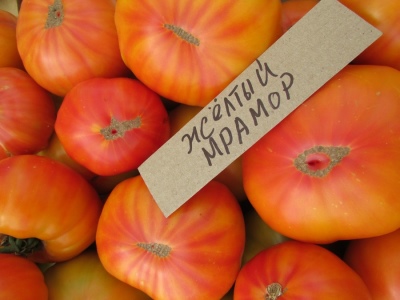
- Category: grade
- Growth type: indeterminate
- Appointment: fresh consumption
- Growing conditions: for greenhouses
- Bush size: tall
- Bush height, cm: up to 250
- Ripe fruit color: yellowish, with red streaks
- Fruit shape: rounded, slightly ribbed
- Fruit weight, g: up to 800
- Pulp: very meaty
Comparing to a beautiful natural stone is a great endorsement for many things. But in order to use the same Yellow Marble tomato correctly, knowing its exact name is not enough. We'll also have to study the characteristic features and key features, as well as the main nuances of circulation.
Description of the variety
Although Yellow Marble is an indeterminate tomato, its bushes can grow up to 2.5 m. The plant is excellent for greenhouse cultivation. It can be grown outside greenhouses only in favorable conditions in the southern regions of the Russian Federation.
The main qualities of the fruit
These berries are characterized by a yellowish color. The main color is diluted with reddish veins. Their largest average weight is 0.8 kg, in some specimens it reaches 1 kg. In shape, the fruit resembles a simple circle. His ribs are barely pronounced.
Taste characteristics
Tomatoes Yellow marble is mainly consumed fresh, but also used for juices and ketchups. Whole fruit canning is not possible. The pulp of the fruit is distinguished by its powerful fleshiness. They also note the oiliness of this pulp and some difference in its color in different parts of the fruit. The taste is generally pleasant. It has an optimal balance of sweetness and acidity.
Ripening and fruiting
The variety belongs to the mid-season group. You can remove the first berries in 114-120 days after germination. At this point, they are already mature enough and developed. Moreover, ripe yellow marble tomatoes also look original.
Yield
In terms of productivity, this variety can confidently challenge many demand leaders. During the season, picking berries per 1 sq. m is able to reach 12 kg.
The timing of planting seedlings and planting in the ground
Sowing usually starts in March. In some cases, this procedure is delayed a little, sometimes even until the first ten days of April. Traditionally, it is necessary to be guided by the climate of the region and horticultural expectations. Shrubs are transplanted into greenhouses in early May. No earlier than May 20, you can plant strong healthy seedlings in open beds.

Growing tomato seedlings is an extremely important process, because it largely depends on whether the gardener can harvest at all. All aspects must be taken into account, from seedbed preparation to planting in the ground.
Landing scheme
The distance between individual seedlings of seedlings is 0.5 or 0.6 m. This indicator must be observed both for greenhouse and garden cultivation. There are simply no objective reasons to deviate from it. For 1 sq. m should have a maximum of 3 bushes. They are first formed into 2 barrels.

Growing and caring
It is necessary to form bushes of Yellow marble in 1-2 stems. Tying will also be absolutely necessary. Top dressing is used once every 14 days. The composition of fertilizers is selected taking into account the growing phase of the plant. So, at the very beginning, you can use nitrogen fertilizers, and a little later, closer to the time of fruiting, the emphasis should be on potassium and phosphorus.
It is worth noting that the developer of the variety recommends planting seedlings aged 45 to 60 days in the final place. A specific reference point for gardeners will be the appearance of the first flower cluster. Overexposure of seedlings is highly undesirable. Backlighting is very important for their full development. Otherwise, there will be no special moments associated with the cultivation of this particular variety.
In the first 5-7 days after planting in the final place, it is undesirable to water any varieties of tomatoes. An exception is made only for extremely hot and dry weather. All experts recommend that greenhouses be ventilated more often. The greenhouse culture should be grown at least once every 7-10 days. Along with the usual, foliar dressings should also be used.




A plant needs different micronutrients at each stage of growth. All fertilizers can be divided into two groups: mineral and organic. Folk remedies are often used: iodine, yeast, bird droppings, eggshells.
It is important to observe the rate and period of feeding. This also applies to folk remedies and organic fertilizers.


Growing regions
Yellow marble is recommended for growing in the middle lane. In areas with more favorable climatic conditions, it is also promising. But in areas with more severe weather conditions, serious problems can arise.

























































































